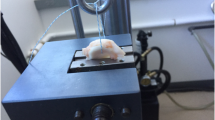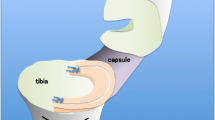Abstract
Purpose
This in vitro biomechanical study investigated the influence of horizontal suture placement distance from the medial meniscal lesion repair site on fixation characteristics during submaximal cyclic and load to failure test conditions.
Methods
Eighteen cadaveric (20–45 years of age) medial menisci with intact joint capsules were harvested within 24–48 h after death and divided into two groups of 9 specimens each for biomechanical testing. A 2.0-cm-long antero-posterior vertical longitudinal lesion was created with a #15 scalpel 2.0–3.0 mm from the outer edge of each meniscus. Menisci were repaired using #2–0 suture material with two horizontal suture loops placed either 1.0 mm (Group 1) or 3.0 mm (Group 2) from the lesion site. Following repair, the lesion was extended completely through the meniscal horns so that no tissue secured the repair, only the two horizontal suture loops representing a “worst-case” testing scenario. Following repair, specimens were placed in a servo hydraulic device using a pair of 1.2-mm-diameter steel wire loops and underwent submaximal cyclic loading between 5 and 50 N (1 Hz) for 500 cycles prior to load to failure testing (5 mm/min crosshead speed, 20 Hz data collection). An alpha level of P < 0.05 was selected to indicate statistical significance.
Results
Five of nine (55.6 %) Group 1 specimens did not complete submaximal cyclic testing. All Group 2 specimens completed submaximal cyclic testing (Fisher’s exact test P = 0.029). Statistically significant mean group differences were not observed for displacement during submaximal cyclic loading (Group 1 = 5.0 ± 1.5 mm and Group 2 = 5.7 ± 1.6 mm) or for construct stiffness during load to failure testing (Group 1 = 50.1 ± 6.3 N/mm and Group 2 = 52.6 ± 11.9 N/mm). Group 2 displayed greater mean load at failure (112.1 ± 40.8 N vs. 72.7 ± 11.2 N, P = 0.02) and mean displacement at failure (11.1 ± 2.2 mm vs. 7.6 ± 1.4 mm, P = 0.03) than Group 1.
Conclusions
Horizontal sutures placed slightly farther away from the meniscus lesion displayed superior repair fixation than sutures placed closer to the lesion. The superior biomechanical meniscal repair fixation provided by capturing greater tissue volume may enable safe earlier participation in functional exercise activities. Studies are needed to verify these findings in vivo.



Similar content being viewed by others
References
Baratz ME, Fu FH, Mengato R (1986) Meniscal tears: the effect of meniscectomy and of repair on intraarticular contact areas and stress in the human knee. A preliminary report. Am J Sports Med 14:270–275
Barber FA, Herbert MA, Schroeder A, Aziz-Jacobo J, Sutker MJ (2009) Biomechanical testing of new meniscal repair techniques containing ultra high-molecular weight polyethylene suture. Arthroscopy 25:959–967
Barber FA, Stone RG (1985) Meniscal repair. An arthroscopic technique. J Bone Joint Surg Br 7:39–41
Becker R, Starke C, Heymann M, Nebelung W (2002) Biomechanical properties undercyclic loading of seven meniscus repair techniques. Clin Orthop Relat Res 400:236–245
Brewer BW, van Raalte JL, Linder DE (1993) Athletic identity: Hercules’ muscle or Achilles heel? Int J Sport Psychol 24:237–254
Brucker PU, Favre P, Puskas GJ, von Campe A, Meyer DC, Koch PP (2010) Tensile and shear loading stability of all-inside meniscal repairs: an in vitro biomechanical evaluation. Am J Sports Med 38:1838–1844
Fisher SR, Markel DC, Koman JD, Atkinson TS (2002) Pull-out and shear failure strengths of arthroscopic meniscal repair systems. Knee Surg Sports Traumatol Arthrosc 10:294–299
Hsieh HH, Walker PS (1976) Stabilizing mechanisms of the loaded and unloaded knee joint. J Bone Joint Surg Am 58:87–93
Johnson RJ, Kettelkamp DB, Clark W, Leaverton P (1974) Factors affecting late results after meniscectomy. J Bone Joint Surg Am 56:719–729
Kocabey Y, Nyland J, Isbell WM, Caborn DNM (2004) Patient outcomes following T-Fix meniscal repair and a modifiable, progressive rehabilitation program, a retrospective study. Arch Orthop Trauma Surg 124:592–596
Kocabey Y, Taser O, Hapa O, Guclu A, Bozdag E, Sunbuloglu E, Doral MN (2011) Meniscal repair using large diameter horizontal sutures increases fixation strength: an in vitro study. Knee Surg Sports Traumatol Arthrosc 19:202–206
Kocabey Y, Taser O, Nyland J, Doral MN, Demirhan M, Caborn DN, Sarban S (2006) Pullout strength of meniscal repair after cyclic loading: comparison of vertical, horizontal, and oblique suture techniques. Knee Surg Sports Traumatol Arthrosc 14:998–1003
Krause WR, Pope MH, Johnson RJ, Wilder DG (1976) Mechanical changes in the knee after meniscectomy. J Bone Joint Surg Am 58:599–604
Kurosawa H, Fukubayashi T, Nakajima H (1980) Load-bearing mode of the knee joint: physical behavior of the knee joint with or without menisci. Clin Orthop Relat Res 149:283–290
Lamprakis AA, Fortis AP, Kostopoulos V, Vlasis K (2009) Biomechanical testing of a shape memory alloy suture in a meniscal suture model. Arthroscopy 25:632–638
Langford JL, Webster KE, Feller JA (2009) A prospective longitudinal study to assess psychological changes following anterior cruciate ligament reconstruction surgery. Br J Sports Med 43:377–381
MacConaill MA (1950) The movements of bones and joints 3. The synovial fluid and its assistants. J Bone Joint Surg Br 32:244–252
McDermott ID, Richards SW, Hallam P, Tavares S, Lavelle JR, Amis AA (2003) A biomechanical study of four different meniscal repair systems, comparing pull-out strengths and gapping under cyclic loading. Knee Surg Sports Traumatol Arthrosc 11:23–29
Noyes FR, Heckmann TP, Barber-Westin SD (2012) Meniscus repair and transplantation: a comprehensive update. J Orthop Sports Phys Ther 42:274–290
Pujol N, Barbier O, Boisrenoult P, Beaufils P (2011) Amount of meniscal resection after failed meniscal repair. Am J Sports Med 39:1648–1652
Richards DP, Barber FA, Herbert MA (2008) Meniscal tear biomechanics: loads across meniscal tears in human cadaveric knees. Orthopedics 31:347–350
Voloshin AS, Wosk J (1983) Shock absorption of meniscectomized and painful knees: a comparative in vivo study. J Biomed Eng 5:157–161
Zantop T, Temmig K, Weimann A, Eggers KA, Raschke MJ, Petersen W (2006) Elongation and structural properties of meniscal repair using suture techniques in distraction and shear force scenarios. Am J Sports Med 34:799–805
Author information
Authors and Affiliations
Corresponding author
Rights and permissions
About this article
Cite this article
Kocabey, Y., Taser, O., Nyland, J. et al. Horizontal suture placement influences meniscal repair fixation strength. Knee Surg Sports Traumatol Arthrosc 21, 615–619 (2013). https://doi.org/10.1007/s00167-012-1995-5
Received:
Accepted:
Published:
Issue Date:
DOI: https://doi.org/10.1007/s00167-012-1995-5




